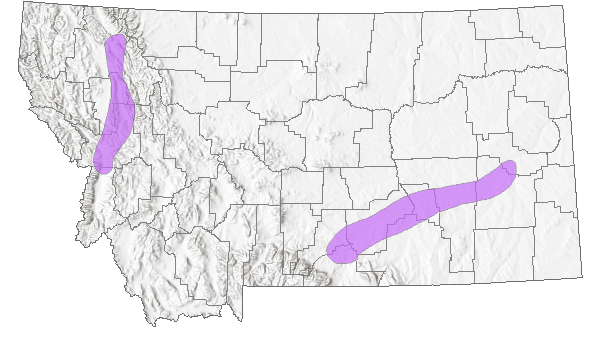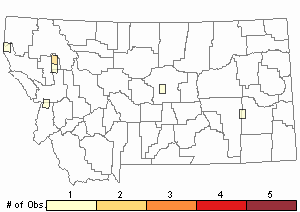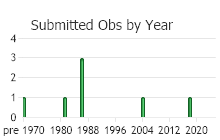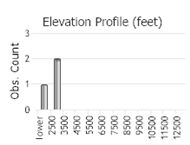View in other NatureServe Network Field Guides
NatureServe
Montana
Utah
Wyoming
Idaho
Wisconsin
British Columbia
South Carolina
Yukon
California
New York
Blue Violet - Viola sororia
Other Names:
Woodland Violet,
Viola septentrionalis
Native Species
Global Rank:
G5
State Rank:
S2S4
(see State Rank Reason below)
C-value:
Agency Status
USFWS:
USFS:
BLM:
External Links
State Rank Reason (see State Rank above)
Viola sororia occurs predominantly in the northwestern portion of Montana. The Fallon County record is based on a 1943 herbarium specimen annotated by McKinney (1986). The Fergus County record is based on an annotated 2004 herbarium specimen that was collected in a yard and may not represent a 'natural' population. The taxonomy of Viola has been difficult to understand due to hybridization and environmentally induced morphology, particularly for the acaulescent, blue violets (McGregor et al. [eds.] 1986; Little in Flora of North America 2015). The Montana Natural Heritage Program is following the Viola treatment by Little in the Flora of North America (2015), which lumps Viola septentrionalis in with Viola sororia. In northwest Montana Viola sororia occurs in moist, low elevation forests. Although the habitat is common, the number of records are few and timber harvesting is a potential threat, which could warrant a Species of Concern ranking. Given that observation data is old and taxonomy in Montana needs to be better understood, survey data that brings forth information is greatly needed before refining its status and rank in Montana.
- Details on Status Ranking and Review
Range Extent
ScoreF - 20,000-200,000 sq km (~8,000-80,000 sq mi)
Comment49,462 square kilometers.
Area of Occupancy
ScoreD - 6-25 4-km2 grid cells
CommentMontana can be divided into 30,390 4x4 square kilometer cells. For this species plant observations occur in 7 of these 4x4 square kilometer cells.
Number of Populations
ScoreB - 6 - 20
Comment7 observations: 1 (1943), 6 (1981-2004)
Environmental Specificity
ScoreC - Moderate. Generalist or community with some key requirements scarce
CommentPlants grow in low elevation, moist forests.
Threats
ScoreC - Medium
CommentForest logging is a potential threat.
General Description
PLANTS: Perennial herbs that lack a central stem (acaulescent) where the flower peduncle and leaf petiole grow directly from a thick, fleshy rhizome. Plants are 5-50 cm tall. Source: Little in Flora of North America [FNA] 2015.
LEAVES: Basal, 1-8 in number, with petioles, and are ascending to erect. Petioles are 2-25 cm, glabrous or hairy (pubescent). Blades are simple (unlobed), not fleshy, ovate to reniform, 2-5 cm by 2-10 cm. Leaf margins are either ciliate or not and crenate to serrate. Leaf apex is acute to rounded. Base of the blade is cordate. Surfaces are often pubescent and rarely glabrous. Stipules are linear- to broadly-lanceolate, entire margins, and acute tips, and sometimes glanular. Source: Little in FNA 2015.
INFLORESCENCE: A single flower that is scapose and arises from a rhizome. Peduncles are 3-25 cm long, glabrous or sparsely pubescent. Sepals are 5 in number, separate, lanceolate to ovate in shape, margins are ciliate or not, and have 1-2 mm long auricles. Petals are 5 in number, separate, and range in color from light to dark blue, dark purple-violet, or reddish purple and usually have a white base. The lower lateral 2 petals are bearded and sometimes purple-veined. The lowest petal may or may not be bearded and is 15-25 mm long. The sac-like spur is colored the same as the petals, swollen on one side (gibbous), and 2-3 mm long. Fruit is a capsule. Source: Little in FNA 2015.
Viola is the Latin name for the plant, derived from the Greek word ion for 'violet' (Little in FNA 2015; Giblin et al. [eds.] 2018).
Phenology
Flowering from March to June (Little in FNA 2015).
Diagnostic Characteristics
Viola species exhibit great phenotypic variation. Leaf and stem sizes usually increase a lot between early spring and late summer (Little
in FNA 2015). Stem, leaf, and flower sizes vary with environmental factors, such as aspect, light, soil moisture, and other soil properties (Little
in FNA 2015). Hybridization among the blue-flowered, acaulescent Violets in eastern North America is well documented (Little
in FNA 2015).
Viola septentrionalis was described as having a distinct capsule and seed morphology based on a review of no more than four specimens (Little
in FNA 2015).
Viola septentrionalis has also been observed as a northern form of
Viola sororia (Little
in FNA 2015). Given the variability in
Viola sororia morphology across its range, Little's treatment in the Flora of North America (2015) found no valid reason to recognize
Viola septentrionalis.
Viola affinis and many of the
Viola nephrophylla herbarium specimens across their range were considered to essentially be the same taxon (Little
in FNA 2015). However, in a taxonomic revision of the 'blue-flowered, acaulescent Violets' McKinney (1992) maintained the separation of
Viola affinis and
Viola nephrophylla.
Viola affinis (and the synonym of
Viola sororia var.
affinis) is considered to occur in North America in Ontario, Minnesota, and eastward (Little
in FNA 2015). Specimens collected in Montana and annotated to
Viola sororia var. affinis are referred back to what was often their original identification as
Viola nephrophylla.
Montana specimens annotated to
Viola septentrionalis have these characteristics (Lesica et al. 2012):
*Stems: Acaulescent without stolons or rhizomes.
*Inflorescence: Peduncles 5-10 cm long, puberulent.
*Leaves: Blades 2–4 cm wide, broadly cordate with dentate margins.
*Stipules: Long-attenuate, fringed.
*Flowers: Deep blue or violet, 15–25 mm long. Lower petals bearded. Sepals ciliate on the margins. Spur 1–2 mm long. Style tip glabrous.
*Fruit: Capsule orbicular.
*Habitat: Moist to wet, often riparian forest.
Viola nephrophylla - Northern Bog Violet [Source is Lesica et al. 2012 unless otherwise noted.]
*Stems: Acaulescent without stolons and rhizomes. Rhizomes present (Little
in FNA 2015).
*Inflorescence: Peduncles 5-20 cm long, usually glabrous.
*Leaves: Blades 2–5 cm wide, broadly cordate with dentate margins.
*Stipules: Narrow. Margins entire or with a border of hairs and apex acute (Little
in FNA 2015).
*Flowers: Deep blue or violet, 12–25 mm long. Lower 3 petals bearded and with a white base. Sepals ovate and without cilia on the margins. Spur 2–3 mm long. Spur 1-2 mm (Little
in FNA 2015). Style tip glabrous.
*Fruit: Capsule 6-8 mm long.
*Habitat: Wet, organic soil of meadows, marshes, and fens.
Species Range
Montana Range
Range Descriptions

 Native
Native
Range Comments
British Columbia to Newfoundland in Canada south to Montana, Utah, New Mexico, and Texas in the U.S. but apparently not in Alberta or Wyoming (Little in FNA 2015).
Observations in Montana Natural Heritage Program Database
Number of Observations: 7
(Click on the following maps and charts to see full sized version)
Map Help and Descriptions
Relative Density

Recency



 (Observations spanning multiple months or years are excluded from time charts)
(Observations spanning multiple months or years are excluded from time charts)
Habitat
Moist to wet, often riparian forest in the valley zone of Montana (Lescia et al. 2012). Dry to mesic habitats in woods, thickets, stream banks, moist prairies, pastures, and disturbed ground, but no in saturated soils and from sea level to 3,000 meters (Little in FNA 2015).
Ecology
POLLINATORS The following animal species have been reported as pollinators of this plant species or its genus where their geographic ranges overlap:
Bombus vagans,
Bombus pensylvanicus,
Bombus bimaculatus,
Bombus griseocollis, and
Bombus impatiens (Colla and Dumesh 2010, Williams et al. 2014).
Reproductive Characteristics
Plants reproduce from seeds and rhizomes.
FLOWERS [Adapted from Lesica et al. 2012; Little in FNA 2015]
Flowers are cleistogamous, which means they self-pollinate and set a fertile seed without the flower opening. These flowers may be found on prostrate or ascending peduncles.
SEED DISPERSAL [Adapted from Little in FNA 2015]
Violets have capsules that split into three valves, which are usually thick in perennial species such as Prairie Violet, and thin in annual species. Some species have capsules that open relatively slowly to expose the seeds. Other species have capsules that as they dry will cause the valves to contract and squeeze the seeds which ejects them. Violet species that have downward pointing capsules passively release seeds while those on erect peduncles ballistically disperse seeds.
Some species disperse their cleistogamous seeds into the soil or duff.
Most Violet species have a fleshy appendage or covering (aril) on the seed that is oil-rich (elaiosome), which is attractive to ants; thus, seeds are dispersed by ants (myrmecochory).
Stewardship Responsibility
Threats or Limiting Factors
In Montana timber harvest is a potential threat.
References
- Literature Cited AboveLegend:
 View Online Publication
View Online Publication Colla, S.R. and S. Dumesh. 2010. The bumble bees of southern Ontario: notes on natural history and distribution. Journal of the Entomological Society of Ontario 141:39-68.
Colla, S.R. and S. Dumesh. 2010. The bumble bees of southern Ontario: notes on natural history and distribution. Journal of the Entomological Society of Ontario 141:39-68. Douglas, G.W., D. Meidinger, and J. Pojar, editors. 2000. The Illustrated Flora of British Columbia. Volume 5. Dicotyledons (Salicaceae through Zygophyllaceae) and Pteridophytes. British Columbia Ministry of Environment, Lands and Parks and British Columbia Ministry of Forests, Victoria.
Douglas, G.W., D. Meidinger, and J. Pojar, editors. 2000. The Illustrated Flora of British Columbia. Volume 5. Dicotyledons (Salicaceae through Zygophyllaceae) and Pteridophytes. British Columbia Ministry of Environment, Lands and Parks and British Columbia Ministry of Forests, Victoria. Flora of North America Editorial Committee, eds. 2015. Flora of North America north of Mexico, Volume 6. Magnoliophyta: Cucurbitaceae to Droseraceae. Oxford University Press, Inc. New York.
Flora of North America Editorial Committee, eds. 2015. Flora of North America north of Mexico, Volume 6. Magnoliophyta: Cucurbitaceae to Droseraceae. Oxford University Press, Inc. New York. Lesica, P., M.T. Lavin, and P.F. Stickney. 2012. Manual of Montana Vascular Plants. Fort Worth, TX: BRIT Press. viii + 771 p.
Lesica, P., M.T. Lavin, and P.F. Stickney. 2012. Manual of Montana Vascular Plants. Fort Worth, TX: BRIT Press. viii + 771 p. McGregor, R.L. (coordinator), T.M. Barkley, R.E. Brooks, and E.K. Schofield (eds). 1986. Flora of the Great Plains: Great Plains Flora Association. Lawrence, KS: Univ. Press Kansas. 1392 pp.
McGregor, R.L. (coordinator), T.M. Barkley, R.E. Brooks, and E.K. Schofield (eds). 1986. Flora of the Great Plains: Great Plains Flora Association. Lawrence, KS: Univ. Press Kansas. 1392 pp. Williams, P., R. Thorp, L. Richardson, and S. Colla. 2014. Bumble Bees of North America. Princeton, NJ: Princeton University Press. 208 p.
Williams, P., R. Thorp, L. Richardson, and S. Colla. 2014. Bumble Bees of North America. Princeton, NJ: Princeton University Press. 208 p.
- Additional ReferencesLegend:
 View Online Publication
View Online Publication
Do you know of a citation we're missing? Britton, N. L. and A. B. Brown. 1913. An Illustrated Flora of the Northern United States, Canada, and the British Possessions. 2nd Edition in 3 Volumes. New York, NY: Charles Scribner's Sons. B13BRI01PAUS.
Britton, N. L. and A. B. Brown. 1913. An Illustrated Flora of the Northern United States, Canada, and the British Possessions. 2nd Edition in 3 Volumes. New York, NY: Charles Scribner's Sons. B13BRI01PAUS. DuBois, K.L. 1979. An inventory of the avifauna in the Long Pines of Southeastern Montana. M.Sc. Thesis. Bozeman, MT: Montana State University. 113 p.
DuBois, K.L. 1979. An inventory of the avifauna in the Long Pines of Southeastern Montana. M.Sc. Thesis. Bozeman, MT: Montana State University. 113 p. Hitchcock, C.L. and A. Cronquist. 2018. Flora of the Pacific Northwest: An Illustrated Manual. Second Edition. Giblin, D.E., B.S. Legler, P.F. Zika, and R.G. Olmstead (eds). Seattle, WA: University of Washington Press in Association with Burke Museum of Natural History and Culture. 882 p.
Hitchcock, C.L. and A. Cronquist. 2018. Flora of the Pacific Northwest: An Illustrated Manual. Second Edition. Giblin, D.E., B.S. Legler, P.F. Zika, and R.G. Olmstead (eds). Seattle, WA: University of Washington Press in Association with Burke Museum of Natural History and Culture. 882 p. Lesica, P., M.T. Lavin, and P.F. Stickney. 2022. Manual of Montana Vascular Plants, Second Edition. Fort Worth, TX: BRIT Press. viii + 779 p.
Lesica, P., M.T. Lavin, and P.F. Stickney. 2022. Manual of Montana Vascular Plants, Second Edition. Fort Worth, TX: BRIT Press. viii + 779 p. Simanonok, M.P. and L.A. Burkle. 2019. Nesting success of wood-cavity-nesting bees declines with increasing time since wildfire. Ecology and Evolution 9:12436-12445.
Simanonok, M.P. and L.A. Burkle. 2019. Nesting success of wood-cavity-nesting bees declines with increasing time since wildfire. Ecology and Evolution 9:12436-12445.
- Web Search Engines for Articles on "Blue Violet"





